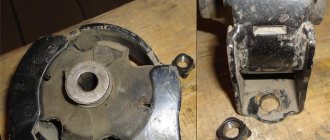In 1999, Toyota released a new 4ZZ-FE engine . Rolled off the assembly line for ten years , it was installed on the well-selling front-wheel drive Corolla and Auris . The unit had a volume of 1.4 liters and was equipped with a variable valve timing system ( VVT-i ). The 4ZZ engine is not alone; along with it, the family includes 1ZZ-FE, 1ZZ-FED, 2ZZ-GE and 3ZZ-FE.
Engine 4ZZ-FE
Characteristics of the 4ZZ-FE engine
The 4ZZ-FE engine has the following technical characteristics:
- years of manufacture – 1999-2009;
- exact volume – 1398 cc. ;
- power (hp) – 97;
- torque (N/m) – 130;
- compression ratio - 10,5;
- The frequency of lubricant changes is every 10,000 km , but it is better to do this more often ;
- permissible oil consumption – up to 1 liter per 1000 km ;
- the volume of oil in the engine is 3.7 liters , after working on the errors in 2005, the volume of lubricant in the 4ZZ engine was increased by half a liter;
- environmental class – Euro4 ;
- fuel used – Au 95 ;
- power supply – injector ;
- aluminum cylinder block with cast iron liners;
Cylinder block 4ZZ-FE - number of cylinders – 4;
- valves per cylinder - 4;
- cylinder diameter – 79 mm ;
- piston stroke - 71.3 mm ;
- operating temperature – 95 degrees. ;
- timing drive – chain;
approximate resource – about 200 thousand.
Fuel consumption
Gasoline consumption largely depends on the type of car the engine is installed on.
Toyota Corolla E150
Toyota Corolla E150 equipped with 4ZZ-FE paired with a 5-speed manual ( liters per 100 km ):
- city - 8,6;
- route – 5,7;
- mixed – 6,7.
Toyota Corolla E120
Toyota Corolla E120 4ZZ with 5 manual transmission : 8.4 / 5.8 / 6.7 .
Toyota Auris E150 with a 1.4 engine and five-speed manual : 8.7 / 5.9 / 6.9 .
Conclusions – is the Toyota power unit good?
Probably, the ZZ line turned out to be one of the most unsuccessful in the Toyota corporation. Even if you regularly pour expensive oil and install original filters, you have practically no chance of reaching 250,000 km. The motor falls apart after the end of its unspoken life. Spare parts for it are quite expensive, contract engines are available, their price starts at 25,000 rubles. But if the 4ZZ is out of order, you can choose something more presentable for your car.
In operation with 4ZZ-FE, a lot of all sorts of troubles also occur. Minor repairs will be expensive for the owner. All this suggests that the unit is not the most reliable, it is generally not subject to major repairs and belongs to the category of disposable installations.
Technical features
Engine 4ZZ-FE (longitudinal section): 1 - hydraulic valve for variable valve timing;
2 — WT-i system controller; 3 - camshaft; 4 - valve; 5 - piston; 6 — auxiliary drive pulley; 7 — main bearing cover; 8 — oil pump; 9 — ignition coil; 10 — camshaft bed; 11 — spark plug; 12 — connecting rod; 13 — rear crankshaft oil seal; 14 - crankshaft The cylinder block is cast from aluminum . Thin-walled cast iron bushings fused into the block body are used as sleeves The outer part of the cartridges is intentionally made uneven. This increases the surface area, makes the connection as strong as possible and improves heat dissipation. A natural advantage of the aluminum body was its weight. Compared to the previous series of engines of the same volume, the weight has decreased by 30 kilograms .
The Toyota 4ZZ-FE engine has “long-stroke” design. Thanks to this, low-end thrust has become higher , and due to the smaller combustion chamber, the thermal load has decreased . But there were some downsides.
High piston speed worsens oil removal and increases demands on the rings. Repairs involving their replacement are a common occurrence.
4ZZ-FE engine crankshaft
In general, when designing the engine, engineers sought to make it as compact as possible and reduce friction, increasing efficiency. And they succeeded. But one of the means to achieve the goal was the reduced diameter and shortened journals of the 4ZZ-FE crankshaft. As a result, the shaft has become more loaded and wears out faster.
With increased speed and stroke length, inertia increases. To eliminate the phenomenon, the piston skirt was shortened, which negatively affected the temperature regime.
Engine piston 4ZZ-FE
The big disadvantage of many modern power plants is their “disposability” . And Toyota is no exception. Major repairs of the 4ZZ engine are not provided by the manufacturer . Of course, there are “handicraftsmen” who re-sleeve the block using non-original parts, but such repairs will not last long.
It is impossible to install new liners correctly even in the factory.
Engine 4ZZ-FE (cross section): 1 - ignition coil;
2.10 - camshafts; 3, 11 — pushers; 4 — exhaust manifold; 5 - piston; 6 — connecting rod; 7 - crankshaft; 8 — oil pump; 9 — cylinder head cover; 12 — nozzle; 13 — inlet pipe; 14 — thermostat; 15 - oil filter The new 1.4 engine replaced the timing belt with a chain . In theory, this should have reduced maintenance costs, but it turned out the opposite. Some drivers, of course, have a chain that lasts more than two hundred thousand kilometers , but there are few such lucky ones. Often the chain stretches after a mileage of 150 thousand . A sign of this is the noise of the mechanism. Neglected cases are fraught with asynchronous operation of the camshaft and crankshaft , which leads to erroneous gas distribution phases.
Rem. timing chain kit
Along with the stretched 4ZZ-FE timing chain, it is necessary to change its tensioner , guides and sprockets . If this is not done, the new chain will last less than its intended life. But since the top sprocket is sold only as an assembly with a gas distribution system drive, few people bother with this.
VVTi valve
The VVTi valve on Toyota engines has a classic design: a linear solenoid that moves a spool valve.
Impurities in the oil cause VVTi valve malfunctions, i.e. particles of coked oil that impair the mobility of the spool. In this case, symptoms such as uneven engine operation, decreased traction, slow increase in speed, uneven jerky acceleration, as well as involuntary jumps in speed when the gear is engaged in neutral arise. In this case, errors are recorded indicating malfunctions in the VVTi system or incorrect camshaft position. In rare cases, an error (P1656) will occur indicating a short circuit in the solenoid of this valve. It is associated with burnout of the chip in the ECU.
Problems with the VVTi system can be resolved by cleaning the control valve strainer. The filter is installed in the cylinder head under the valve. In some cases, removing and cleaning the coupling itself and polishing its worn internal surfaces can help.
You can check the functionality of the valve and the mobility of the spool by briefly applying voltage to it: the valve should click when current is applied. It is advisable to do this check on a hot engine.
Also, the VVTi valve can often leak oil through its body, namely at the junction between the solenoid and the spool. You can combat this leak by halving the valve and changing two o-rings: outer and inner. By the way, due to the deformation of the inner ring, the mobility of the spool is impaired, which affects the operation of the valve.
Success in this repair depends on whether it is possible to securely fix both valve mats, which are held in place by antennae.
Service
Original Toyota lubricant “ENGINE OIL 5W-40”, its article numbers: 0888080375 (5 l) and 0888080376 (1 l)
The oil must be changed every 10 thousand kilometers . of lubricant for the 4ZZ engine that meets API SL/CF , or ACEA A3, B3, B4 . Standard viscosity SAE 0W-30 and 5W-40 , however, this parameter can be changed depending on operating conditions. Original Toyota “ENGINE OIL 5W-40” , its part numbers: 0888080376 ( 1l ) and 0888080375 ( 5l ).
Toyota oil filter art. 90915-10003 (link to image source)
Along with the oil, the oil filter (Toyota 90915-10003 ) and the washer on the drain plug ( 9043012031 ) are changed.
Washer on the drain plug art. 9043012031
At 40,000 mileage the air filter ( 1780121050 ) and plugs ( 9091901164 will need to be replaced .
Air filter art. 1780121050 (left) and spark plug art. 9091901164 (right).
to fill in new coolant for the first time after 180,000 km , after which this interval is reduced to 80 thousand . The original pink antifreeze has article number 888980072 .
Antifreeze Toyota Super Long Life. Concentrate 1 l, article 08889-80140 (right) or already diluted 5 l, art. 08889-80072 (left).
The maintenance regulations state that the timing chain in the 1.4 4ZZ-FE engine lasts the entire life of the vehicle and does not require replacement, but at the first signs of stretching it is better to replace it with a new one, its part number 1350622030 .
Timing chain article 13506-22030
Cylinder head
The cylinder head of 1ZZ-FE engines has an interesting feature: it does not have pressed-in valve seats. Instead, the technology was used to laser spray the seats directly onto the light alloy of the cylinder head itself. That is, if the seats are worn out and “injured,” such a cylinder head cannot be restored.
There are no serious mechanical problems with the cylinder head of 1ZZ engines. But due to the serious consumption of oil due to waste, the surface of the combustion chamber, especially the exhaust valves, becomes covered with a thick layer of soot. Carbon deposits can form on the edges of the exhaust valves, causing them to lose their seal. As a result, compression in the cylinders drops.
You can select and buy a cylinder head for a Toyota engine in our catalog of contract spare parts.
Disadvantages and weaknesses of 4ZZ
The main problem of all engines of the ZZ family is increased oil waste . Moreover, oil burn was a common occurrence even in new cars that were under warranty. The reason for this is the occurrence of rings , which occurs due to fatal errors of designers when designing the engine.
Stuck engine oil rings
And don’t believe those who say that this disease was solved after 2001 . The situation improved slightly only after modernization in 2005 . Then Toyota replaced the entire piston group , including the rings , and increased the oil volume in the crankcase by half a liter.
On the new pistons, the number and diameter of the drainage holes were increased, and recesses were made on the lower part of the rings.
At the end of production, the gasoline 1.4 4ZZ-FE showed another disadvantage - longitudinal play of the crankshaft . The problem was solved by replacing it, along with installing new thrust washers and bearing shells.
Thrust washer (arrow No. 1) and bearing shell (arrow No. 2)
Other weak points are inherent in all Toyota engines. The crackling sound produced by the VVT-i drive when the engine is not warmed up appears more often at high mileage. Another problem lies in the timing , although the factory says that it is enough for the entire service life of the car, in fact the service life of the part is very limited the hydraulic tensioner often fails with it .
Hydraulic timing chain tensioner for 4ZZ-FE engine
Throttle valve
The throttle valve of the 1ZZ-FE engine is cable driven and rarely causes any complaints. It becomes heavily and quickly contaminated with oil deposits due to excess oil or problems in the VCG system.
But if there is noticeable floating of the idle speed, you should remove and wash the idle speed control valve.
You can select and buy a throttle valve for a Toyota engine in our catalog of contract spare parts.
What cars was it installed on?
Toyota Corolla E110 1999
Initially, the 4ZZ-FE engine was installed on the Toyota Corolla E110 ( 1999 - 2002 ).
Toyota Corolla E120
From there it smoothly migrated to the E120 ( 2000 - 2007 ), and then to the Corolla E150 ( 2006 - 2009 ). Another Toyota model under the hood of which you can find this engine is the Auris E150 from 2006 - 2008 .
Toyota Auris E150
Cylinder block
Thin-walled cast iron sleeves cannot be bored. That is, according to the engineers, the 1ZZ engine block is irreparable. Therefore, before trying to cure it of oil burns, you need to measure the cylinders. If there is severe wear and ellipse, replacing the pistons with new ones will not give good results. As a rule, on 1ZZ engines with a strong oil appetite, the hone on the surface of the cylinders is perfectly preserved. The main thing here is to prevent severe degradation of the oil or a significant decrease in its level.
You can select and buy a cylinder block for a Toyota engine in our catalog of contract spare parts.










